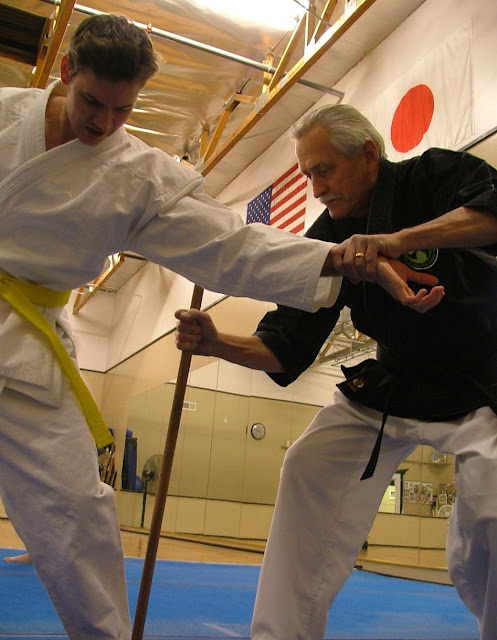The principal focus is Shorin-Ryu Karate & Kobudo in Mesa and for members of Seiyo No Shorin-Ryu Karate Kobudo Kai worldwide, is karate & kobudo (Okinawan Weapons). But in addition to these traditional Okinawan martial arts, students train in self-defense and learn to defend against a variety of attacks including assailants with guns, knives, clubs, rifles etc. Many of the students also train in Samurai Arts including iaido (samurai sword), kenjutsu (samurai sword techniques), naginata (halberd), yari (spear), bo (staff), hanbo (half-staff), jo (4-foot staff), hojo (rope), kobuton (short stick), and jujutsu.
.JPG) |
| Group photo at Corbett Gym, University of Wyoming |
Many students also train with weapons of the Japanese Samurai including hanbo (or short staff). Similar weapons to the hanbo include kioga (or kebo) better known as the expandable baton (Asp), tsune (cane), kobuton (short stick) and manrikigusari (chain or rope).
Hanbo training at the Hombu, East Valley Phoenix, Arizona
|
Members of Arizona School of Traditional Karate in Mesa, learn how to use the hanbo in dozens of different situations for the street. But they also practice against an uke (partner) with a samurai sword as is tradition (as well as against an attacker with other weapons such as tanto [knife]). As they progress, they work up to juji-kumite to develop spontaneity and accuracy of action - in other words, to learn how to react without thinking. Restraints are important so that the hanbo can be used as a pragmatic instrument for law enforcement.
The Hanbo and Kioga are common weapons used by police departments around the world. As a Kyoju of Budo (professor of martial arts) at the University of Wyoming, Soke Hausel taught many law enforcement officials in these arts. But, you don't need to law enforcement officer to learn to use these valuable weapons.
In Seiyo Shorin-Ryu, to progress in hanbojutsu, students demonstrate basic strikes, blocks and stances and several self-defense ippon kumite against unarmed and armed assailants. They also learn very restrictive juji-kumite or sparring with the weapon. The kumite must be controlled and done with safety in mind.
The origin of the hanbo is uncertain. Some researchers suggest it originated quite by accident. According to a summary on Kukishin Ryu, legend suggests that during battle between Kuriyama Ukon and General Suzuki Tangonokami Katsuhisa in 1575, Kuriyama was armed with yari (spear) and Suzuki with katana (sword). During the battle, Suzuki sliced through Kuriyama’s spear cutting it in half, but Kuriyama was still able to overwhelm Suzuki with the remaining spear handle.
Kuriyama realized the importance of the short staff for self-defense and developed hanbo-jutsu. Our members also train in katana and yari and learn these weapons along with many traditional Okinawan kobudo weapons such as nunchaku, sai, tonfa, kama, bo, and others.
Hanbo has been incorporated into several martial arts including taijutsu (体術). Taijutsu is a term used interchangeably with jujutsu. Most koryu (old style) jujutsu styles use arresting techniques for law enforcement. In particular, munadori waza (lapel grab techniques) are the focus of many of these arts.
Shaku is the archaic unit of measure used until the Japanese adopted the metric system in 1961. Prior to 1961, shaku was a common unit of measure equal to 11.93 inches, or nearly one-foot. The shaku was derived from nature and is the average length between mature bamboo nodes.
But the Japanese also had a second shaku - to make things confusing. This latter shaku was equal to 14.9 inches or the length of an average whale’s whisker which was adopted in 1881 to measuring cloth. To distinguish between these two, the cloth shaku was referred to as kujirajaka (kujira meaning whale); and the bamboo shaku was referred to as kanejaku. For me, I was surprised to find out that whale's had whiskers.
The hanbo is still used in training by many Japanese law enforcement agents. And it became very promintent during the late 19th Century during the Edo Period, when some law enforcement officers were armed with wooden staffs and were responsible for disarming samurai. These people worked in teams and attacked criminals simultaneously to disarm and restrain them with a rope - another art taught at our dojo - hojojutsu.
Following the Edo period, the Meiji Restoration began in 1868, known as the beginning of the modern era of Japan. During the Edo period, samurai were still important and privileged individuals. But a chain of events led major changes in the political and social system in Japan resulting in opening their door to gaijin of the Western World. During the Meiji, members of the samurai class were eliminated and the honor of wearing swords was prohibited. This was followed by all Japanese males being required to serve in the military for 4 years.
These events caused considerable unrest with samurai, who prior to this event, were allowed to bear arms – unlike peasants. A samurai rebellion resulted and many hanbo waza were developed at this time to evade strikes by katana followed with follow-up strikes to head or sword hand, or thrusts to the attacker's body. Included in this were many take downs followed by restraints.
Our classes at the Arizona School of Traditional Karate in Mesa, Arizona at 60 W. baseline Road, across the street from SunDevil Auto and learn this and other weapons.
 |
| Osensei Bill Borea applies yubi uchi (toe strike). |
+during+Utah-Arizona+clinic+in+Mesa+and+Gilbert.JPG)


.jpg)







